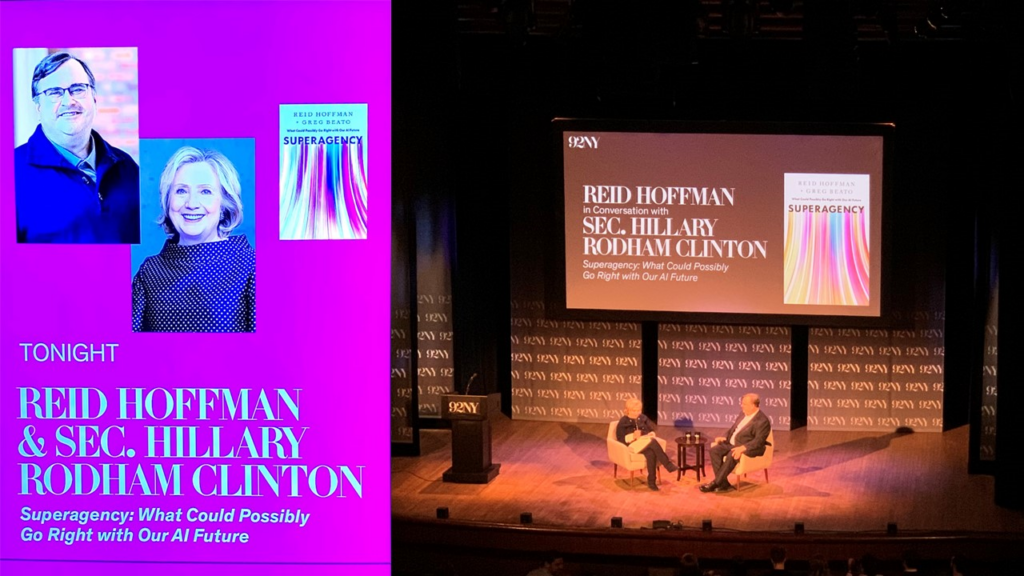Doomers, Bloomers, and Zoomers: Clinton & Hoffman Weigh in on AI’s Future
Where do you stand on AI—optimist or skeptic? A high-stakes conversation on AI’s promise, risks, and the global race for leadership in this game-changing technology.
Published January 31, 2025
By Brooke Grindlinger, PhD
Chief Scientific Officer

The emergence of artificial intelligence (AI) is reshaping nearly every aspect of human life. From medicine to transportation, education to industry, AI is not just a tool; it’s an evolving partner in human progress. But what does this transformation mean for individuals, society, and the growing geopolitical tensions between nations vying for dominance in AI technology? These questions were at the heart of a recent conversation between former US Secretary of State Hillary Rodham Clinton and Reid Hoffman, co-founder of LinkedIn and co-author—with tech writer Greg Beato—of the new book Superagency: What Could Possibly Go Right with Our AI Future.
At its core, Superagency presents an optimistic vision of AI as a general-purpose technology that amplifies human agency. This concept was brought to life for the evening’s audience through a video appearance by Reid AI—Hoffman’s digital twin—who, with the enthusiasm of a tireless press agent, championed Superagency and its vision. “Superagency describes not only how we as individuals get these superpowers from technology, but also how we benefit from a society in which millions of others have these superpowers.” This perspective challenges alarmist narratives around AI, instead framing it as a transformative force, much like past technological revolutions such as the printing press and the automobile.
AI as an Opportunity: Learning from the Past
History teaches us that every major technological advancement—from the steam engine to the internet—has been met with both excitement and trepidation. AI is no different. Hoffman pointed out that skepticism surrounding AI today mirrors historical anxieties: “When, for example, you go back to the printing press, the dialogue around the printing press was actually very similar to the dialogue around AI. It was things like ‘This will spread a lot of misinformation. This will destroy our institutions and our ability to discern truth.’” And yet, despite the upheavals they caused, these innovations propelled society forward. The challenge, Hoffman argues, is to navigate AI’s development thoughtfully, ensuring its benefits reach the many rather than the few.
The AI Spectrum: Doomers, Gloomers, Bloomers, and Zoomers
In Superagency, Hoffman describes a spectrum of attitudes toward AI. On one end are the Doomers, who believe AI is an existential threat that could bring about catastrophic consequences. Next are the Gloomers, who are skeptical and advocate for stringent regulatory controls but stop short of outright rejection. The Zoomers, by contrast, are those who champion rapid AI expansion without much concern for potential risks and are often anti-regulation. Finally, Hoffman identifies himself among the Bloomers, a group that believes AI, when properly guided by intelligent risk management, can be an overwhelmingly positive force for humanity. “One of the things that we argue for, as part of the case for optimism—being Bloomers—is to say you don’t expect perfection in the beginning,” Hoffman explained.
During their conversation, Hoffman asked Secretary Clinton where she saw herself on this spectrum. Her response was thoughtful: “Well, I think I’m a Boomer who is somewhere between a Bloomer and a Gloomer, because on the one hand, I really appreciate the optimism. I find that very attractive. We should learn as we do, learn as we go, make adjustments…Although I do worry about all the people who don’t see the curb and drive off over the cliff.” Her remark underscores the need for both enthusiasm and caution—embracing AI’s potential while ensuring that adequate safeguards are in place to prevent harm. Clinton continued, “We know a lot now. We don’t know anywhere near what we’re going to know, and maybe there are some kinds of guardrails that we would want without losing the optimism, because I want this country to dominate AI.”
Guardrails for Progress: The Role of Regulation
While AI’s potential is vast, so are the risks. Secretary Clinton raised a crucial concern: “If you look at the aggregate, is it going to be more difficult, given our political and social and economic environment, to say, ‘Hey, wait a minute, we’ve learned enough that maybe we should put on this guardrail. Maybe this should be a certain standard we try to meet.’”
Hoffman acknowledged the difficulty of balancing innovation with regulation but emphasized that responsible AI development requires ongoing assessment rather than outright restriction. “The attempt to hold any kind of large system to zero error is an attempt to stop the future,” he noted. Instead, he advocates for an iterative approach—adjusting regulations as AI evolves, rather than stalling progress in the name of perfection.
Hoffman compared this process to the development of the automobile. Early cars lacked essential safety features, but over time, society introduced refinements—first bumpers, then seatbelts, then airbags—to make vehicles safer without halting progress. We have to start driving before we realize what safeguards we need. AI, he argued, should follow the same evolutionary path, improving with real-world use and responsive adjustments.
The Global AI Race: Maintaining US Leadership
One of the most urgent topics in the conversation was the global competition in AI development, particularly between the United States and China. Secretary Clinton emphasized that the US cannot afford to fall behind: “I do worry that if we don’t have an optimistic, full speed ahead approach to it, that we will get outmaneuvered, that we will find ourselves in a subordinate position and that subordinate position could be one of great risk and potential danger. I still would rather have us struggling to try to make the right decisions than seeding ground to rogue states, to highly organized states, to criminal organizations, to rogue technologists.”
Hoffman echoed this sentiment, stressing that America’s strength lies in its innovative culture and entrepreneurial spirit. “We do it by the American entrepreneurial networks and the creativity, but we have to go at that, and we have to be saying that’s what we want.”
Recent developments highlight the stakes of this competition. Just days before this conversation, Chinese AI company DeepSeek made headlines with its advancements in large language models, demonstrating China’s accelerating capabilities in AI development. The rise of DeepSeek underscores the urgency for the US to not only invest in cutting-edge AI research but also establish ethical frameworks that ensure responsible deployment of the technology. This competition is not just about economic dominance; it’s about setting standards for ethical AI use worldwide. The key to maintaining leadership, Hoffman argued, is to ensure that AI development remains aligned with democratic values and responsible governance. If the US leads with innovation and responsibility, it can shape AI’s trajectory for the benefit of society at large.
AI as a Catalyst for Global Stability
Beyond economic and technological dominance, AI could play a significant role in shaping global stability. Hoffman suggested that AI-driven economic and educational advancements could reduce geopolitical tensions by fostering growth in underdeveloped regions. “When people think their future is likely to be better than their present, in terms of building things, they tend to go to war less,” he noted. If AI can be harnessed to improve healthcare, education, and job opportunities in struggling economies, it has the potential to serve as a stabilizing force rather than a disruptive one. This approach shifts the conversation from AI as a competition to AI as a tool for global peace and cooperation.
In contrast, during the discussion, an audience member raised concerns about AI’s potential use in warfare. Secretary Clinton acknowledged the risks, stating, “A lot of weapons of war are becoming more and more autonomous. And so we’re going to see all kinds of very dangerous weapons in the hands of all kinds of people that may or may not have the values that they should to be entrusted with that kind of destruction.” Hoffman reinforced this point, cautioning that AI’s offensive capabilities could be destabilizing: “One of the challenges with AI is that it’s inherently a little bit more of an offensive weapon and has the tendency to say ‘use it or lose your advantage’”, which is most worrisome in terms of a potential arms race dynamic. The exchange highlighted the delicate balance of leveraging AI for progress while preventing its potential misuse in global conflicts.
A Call to be AI “Curious”
As AI continues to evolve, engagement and understanding are critical. Rather than passively observing its impact, scientists, policymakers, and the public must take an active role in shaping AI’s future. As Hoffman puts it: “Move to being AI curious. It doesn’t matter if you are also at the same time AI uncertain, AI skeptical, AI fearful—but add AI curiosity into it.” The AI revolution is here. The question is not whether AI will change our world, but how we choose to participate and shape that change. By fostering curiosity, implementing smart regulations, and ensuring equitable opportunities, we can make AI a tool for empowerment rather than disruption.
For those eager to deepen their understanding of AI technologies in the healthcare sector, including leveraging AI for drug discovery, medical imaging, mental health, equity, and affordability, we invite you to join us at the HealthNext AI Summit 2025, March 3-4, 2025 in New York City. Register now with promo code HLTHNXTNYAS for 10% off!
Interested in hearing more from Reid Hoffman? Tune in to Hoffman’s March 2024 conversation with Academy President and CEO Nicholas Dirks about Hoffman‘s prior book, ‘Impromptu: Amplifying Our Humanity Through AI‘. Available On-Demand until March 27, 2025.
